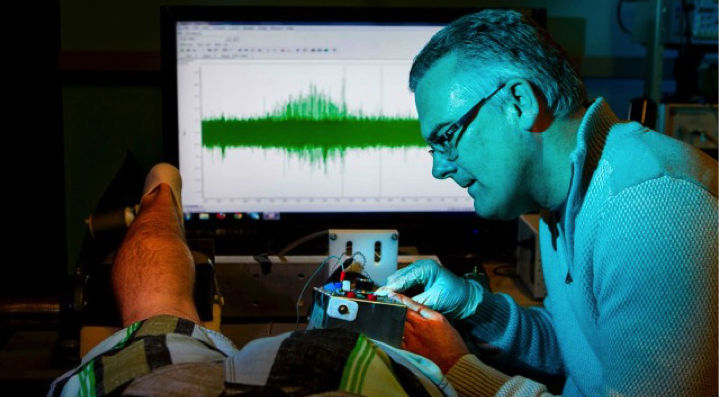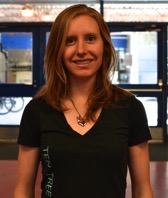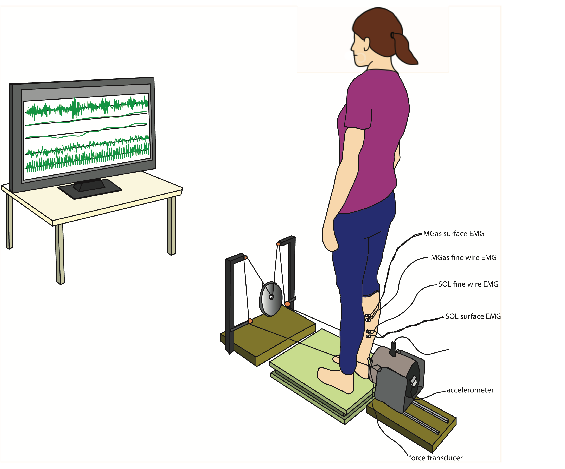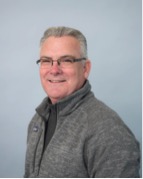
The task of maintaining upright stance in the human involves a complex control system that can use and integrate the bounty of sensory information that surrounds us. The long-term goal of my basic research program is to better understand the fundamental role played by sensory information in the control of standing balance and movement in humans. To investigate this focus, we have developed two areas of research concentration in the School of Kinesiology at the University of British Columbia. In the Human Neurophysiology laboratory, I use a special research technique, termed microneurography, to record the somatosensory neural activity of conscious human subjects. Currently, there are only 5-6 single-unit microneurography laboratories worldwide that use this technique to investigate sensorimotor research issues. We also use either mechanical (motors or robots) or electrical stimulation to evoke reflexes while we record muscle activity through surface and/or indwelling (fine wire) electromyography in many of these studies. In the second research concentration area we are studying how standing balance and locomotion can be affected by manipulating the sensory inputs. In particular, we use another novel research technique, termed electrical vestibular stimulation, to artificially alter the human vestibular system (inner ear balancing system). Research in the Human Neurophysiology laboratory at UBC is funded by equipment (RTI), and operating (Discovery) grants that have been provided by NSERC.
Projects
Reflex Control of Lower Limb Muscles
We are developing novel methods to examine reflex characteristics in posturally active muscles by delivering a subtle noisy stimulus and associating it with ongoing muscle activity. We are also layering different sensory stimuli (skin and muscle) and examining their reflex interactions during standing.
Coding from Lower Leg Skin and Muscle Sensory Afferents
Using microneurography, we can directly record from single sensory nerve fibres that innervated mechanoreceptors in human skin and muscle. We are examining how individual sensory nerve fibres encode sensory stimuli (e.g., pressure, joint movement).
Funding Agencies/Research Affiliations
- ICORD
- Djavad Mowafaghian Centre for Brain Health
- Graduate Program in Neurosciences
- The Peter Wall Institute
People
Principal Investigator (Ed/Employment/Memberships):
Tim Inglis
University of Waterloo, Waterloo B.Sc. 1984
University of Waterloo, Waterloo M.Sc. 1986
Queens University, Kingston Ph. D. 1991
University of Western Ontario, London B.Sc.P.T. 1992;
Current Students

Robyn Mildren
Robyn completed her bachelor’s and master’s degrees at the University of Guelph. Robyn’s MSc research focused on sensory feedback from skin receptors in the foot and their function in tactile perception and proprioception. Robyn’s PhD research aims to characterize lower limb reflexes evoked by skin and muscle sensory stimuli during standing in young adult, older adult, and stroke populations. Outside of the lab, Robyn is a competitive distance runner on the track, road, and trails.

Gregg Eschelmuller
Gregg completed his bachelor’s degree in Kinesiology and Health Sciences at the University of British Columbia. During his undergrad he conducted research on the effects of exercise induced fatigue and muscle damage on kinesthesia in the upper limb and heteronymous reflex pathways in the lower limb in standing. As a MSc student in the Inglis Lab, Gregg plans to continue to his research studying reflex pathways found within the lower limb, with particular interest in their functional significance and contributions to standing balance control.

Tom Kanwischer
Tom will be finishing his undergraduate degree in December. He has been volunteering in Dr. Inglis' lab since September 2017 and will work full-time in the summer. His focus will be on understanding the effects of tendon vibration and vestibular stimulation on both postural sway and upper-limb reaching.
Graduated Students
- Dr. Ryan Peters, Assistant Professor, Faculty of Kinesiology, The University of Calgary.
- Dr. Brian Dalton, Assistant Professor, School of Health and Exercise Science, The University of British Columbia (Okanagan Campus).
- Dr. Billy Luu, Research officer, Neuroscience Research Australia, Syndney, Australia.
- Dr. Jean Sebastien Blouin, Professor, School of Kinesiology, The University of British Columbia (Vancouver Campus).
- Dr. Trevor Birmingham, Professor, Dept. of Physical Therapy, The University of Western Ontario.
- Dr. Chantal Murnaghan, Innovation Manager at Lululemon Athletica.
- Dr. Leah Bent, Human Health and Nutritional Sciences, The University of Guelph.
- Dr. Paul Kennedy, School of Kinesiology, The University of British Columbia (Vancouver Campus).
- Dr. Carissa Wells.
Paul Kennedy, Charla Gray, Sam Brovender, Greg Lee Son, Brian Justin, Brynne Elliot, David Nichol, Melanie Roskell, Sarah Luxon, Shannon Lim, George Gross, Janice lee, Gillian Hinton.
Recent or Selected Publications (Total 122)
- Manzone DM, Inglis JT, Franks IM, Chua R. Relevance-dependent modulation of tactile suppression during active, passive and pantomime reach-to-grasp movements. Behav Brain Res. 2018;339:93-105.
- Zaback M, Horslen BC, Cleworth TW, et al. Influence of emotional stimuli on lower limb cutaneous reflexes during human gait. Neurosci Lett. 2018;664:123-127.
- Peters RM, Dalton BH, Blouin JS, Inglis JT. Precise coding of ankle angle and velocity by human calf muscle spindles. Neuroscience, 2017; 349: 98-105.
- Murnaghan CD, Carpenter MG, Chua R, Inglis JT. Keeping still doesn’t “make sense”: examining a role for movement variability by stabilizing the arm during a postural control task. J Neurophysiol. 2017;117(2):846-852.
- Mildren RL, Peters RM, Hill AJ, Blouin JS, Carpenter MG, Inglis JT. Frequency characteristics of human muscle and cortical responses evoked by noisy Achilles tendon vibration. J Appl Physiol. 2017;122(5):1134-1144
- Horslen BC, Inglis JT, Blouin JS, Carpenter MG. Both standing and postural threat decrease Achilles’ tendon reflex inhibition from tendon electrical stimulation. J Physiol (Lond). 2017;595(13):4493-4506.
- Dalton BH, Rasman BG, Inglis JT, Blouin JS. The internal representation of head orientation differs for conscious perception and balance control. J Physiol (Lond). 2017;595(8):2731-2749.
- Forbes PA, Luu BL, Van der loos HF, Croft EA, Inglis JT, Blouin JS. Transformation of Vestibular Signals for the Control of Standing in Humans. J Neurosci. 2016;36(45):11510-11520.
- Peters RM, Mckeown MD, Carpenter MG, Inglis JT. Losing touch: age-related changes in plantar skin sensitivity, lower limb cutaneous reflex strength, and postural stability in older adults. J Neurophysiol. 2016;116(4):1848-1858.
- Lim, SB, Cleworth TW, Horslen BC, Blouin JS, Inglis JT, Carpenter MG. Postural threat influences vestibular-evoked muscular responses. J. Neurophysiology. 2017; 117:604-611.
- Bent, LR, McFadyen BJ, Inglis JT. Vestibular contributions to dynamic locomotor tasks. Exercise & Sport Sciences Reviews, 2005;Vol.33 (3) 107-113.
- Wells C, Ward LR, Chua R, Inglis JT. Noise increases vibrotactile sensitivity in old and yong adults. Psychological Sciences 2005; 16:4, 313-320.
- Kennedy PM and Inglis JT. Distribution and behavior of glabrous cutaneous receptors in the human foot sole. J. of Physiol (Lond) 2002; 538.3:995-1002.
- Cordo P, Inglis JT, Verschueren S, Collins JJ, Merfeld DM, Rosenblum S, Buckley S, Moss F. Noise in human muscle spindles. Nature 1996;383(6603):769-70.
Opportunities
Please contact Dr. Tim Inglis (tim.inglis@ubc.ca) if interested in inquiring about graduate supervision, volunteer opportunities, or to participate as a subject in one of our ongoing studies.
Contact Us
Office address:Osborne Centre Unit 1,
6108 Thunderbird Blvd,
Room 212
Vancouver, BC V6T 1Z4
604 822-1626
tim.inglis@ubc.ca

